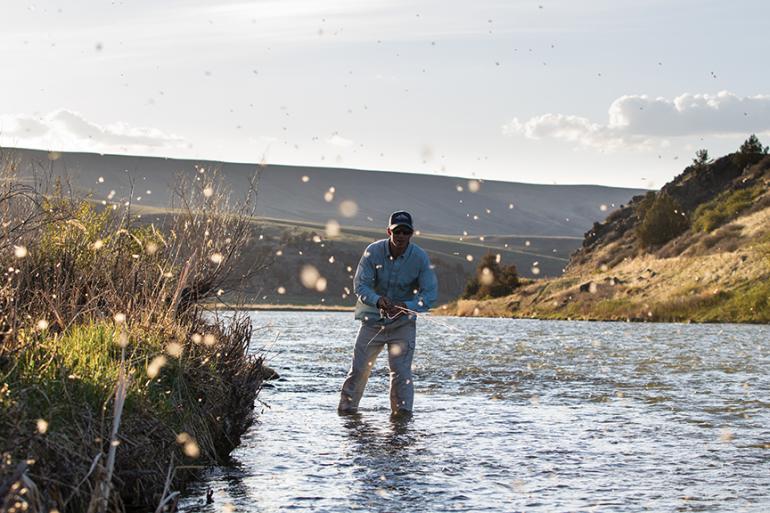Match the Hatch
When to fish what in southwest Montana.
Figuring out what the fish are eating is one of the hardest parts of fly fishing. Here’s a look at the best hatches around southwest Montana.
Midges hatch year-round, but fly fishermen should be primarily concerned with them during the winter months. Midges make up a large percentage of a trout’s diet during the winter, and often are the only way to fish dry flies this time of year. Most midge hatches occur on warmer, cloudy days during the winter; using a midge cluster with a zebra midge underneath is a great way to target these fish.
The blue-winged olive is a mayfly that hatches during winter and early spring. These mayflies require slightly warmer days than midges and become prolific in February and March. They are also more apt to get going on warmer, overcast days. While these flies are present in our river systems year-round, they stop hatching once it heats up in May until it cools down again in September.
Skwalas are a little-known stonefly hatch that occurs in early spring, running from March through early May. This hatch is most famous on the Bitterroot River, but Skwalas are present on the Jefferson, Big Hole, and Beaverhead rivers as well. To match this hatch, fish large, green foam stonefly patterns with a green rubber legs.
Once late April rolls around, the area’s bug activity increases with the ever-popular caddis, one of the summer’s most consistent hatches that can be fished all the way through October. The most famous of the caddis hatches, the Mother’s Day Caddis Hatch, literally produces blankets of caddis on the water that really get the fish worked up.
Beginning in June, another mayfly, the green drake, shows up. A big, burly crawler type of mayfly, these insects don’t hatch in large numbers, so finding feeding fish can be difficult.
Salmonflies, one of Montana’s most sought-after hatches, show up like clockwork the second week of June. These stoneflies spend three years clinging to rocks; once the temperature hits the right mark, they crawl out onto the banks and spend a couple weeks looking for mates and depositing eggs in the water. The hatch, which follows the change in water temperature, has been known to travel three miles upstream in one day. In some areas this hatch accounts for up to 75% of a trout’s yearly caloric intake, giving the angler the opportunity to fish huge dry flies for big, hungry trout.
Golden stones, another large stonefly, usually appear around the same time as the salmonflies. These bugs are very similar to salmonflies in that they live as nymphs for three years, and then crawl out to mate for two to three weeks. Use the same tactics as you do with salmonflies.
Yellow sallies, a small stonefly, break out in our local streams and rivers from June through September. In fishing this very consistent hatch, the effective angler will toss nymphs and then move to dry flies as the day progresses.
Once August hits, our fields start teeming with grasshoppers and cicadas. When the wind picks up and blows these insects into the rivers, the trout key in on them big-time. Fishing a large foam hopper can elicit some vicious hits.
Crane flies are another hatch that occurs late in the summer on a few of our local rivers. Skate these massive flies late in the day, or nymph the crane fly larva after a rainstorm and you’ll have a great day on the river.
The last notable hatch before returning to your BWOs and midges are tricos, which start in July and run until the first frosts of October. These tiny #20 mayflies prefer slack water and can draw up some extremely selective trout.
Jake Adelman is the manager at Montana Troutfitters in Bozeman.












